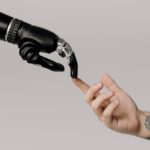What is Liquid AI and Why Should We Care?
As artificial intelligence continues its relentless march into nearly every facet of modern technology, an exciting new frontier has emerged in the form of “liquid” neural networks.
Pioneered by luminaries like MIT’s Daniela Rus, liquid AI promises to revolutionize everything from autonomous vehicles to weather forecasting and beyond.
But what exactly makes it so different from traditional AI?
Let’s dive in and demystify this futuristic field.
The Problem With Conventional AI Models
Before we explore how liquid networks aim to move the needle, it helps to understand why leading experts believe we need more nimble, dynamic machine learning architectures in the first place.
Take language models like GPT-3 for example, which contains a staggering 175 billion parameters and tens of thousands of neural connections.
While massive in scale and capable of impressive linguistic feats, such models have notable downsides:
- Massive computing requirements – Models with billions of parameters suck up ridiculous amounts of energy and hardware resources, limiting accessibility.
- Lack of flexibility – Once trained, parameters are essentially fixed, making it difficult for models to deal with new, unexpected scenarios.
- Limited interpretability – With so many intricately interconnected parts, understanding exactly why models make certain predictions becomes implausible.
We urgently need more “reliable, explainable, and capable” alternatives that address these pain points.
Enter liquid networks.
Fluid Networks For a Changing World
The core inspiration behind liquid AI stems from the innate flexibility of biological brains.
Instead of relying on static connections, liquid networks incorporate dynamical equations that allow each neural component to smoothly adapt its behavior over time.
Resembling more fluid systems found in nature, liquid models can dynamically tweak their parameters and signal exchanges to meet the demands of shifting real-world environments.
Rather than just plowing blindly ahead with fixed settings, they can pivot on the fly like a quick-thinking human driver encountering deteriorating road conditions.
Beyond wielding more natural adaptive capacities, liquid architectures also provide sorely needed hardware and interpretability advantages over conventional deep learning:
- Tiny memory footprint – Where models like GPT-3 require upwards of 700GB, liquid networks can pack extreme efficiency into less than 1GB with fewer than 20 neurons.
- Low power requirements – Their compact dynamical equations are so frugal that liquid models can run seamlessly on small devices like Raspberry Pi’s.
- Enhanced transparency – With a simplified codebase and drastically fewer moving parts, interpreting liquid models becomes far more practical.
Scaling back on brute parameters and hand-coded complexity, liquid AI achieves outstanding performance and generalizability through elegant emergence alone.
Early Successes Show Enormous Promise
While still an embryonic field, liquid networks have already exhibited state-of-the-art capabilities across a variety of prediction and control challenges.
In autonomous aerial navigation tests for example, a liquid model developed by Rus and her team matched and even exceeded traditional deep RL techniques. Despite no fine-tuning and relatively little training data from a human expert pilot, the liquid network reliably steered drones from start to finish in complex outdoor environments full of noise and surprises.
Where other cutting-edge navigation algorithms catastrophically failed in unfamiliar settings they hadn’t seen before, the liquid pilot maintained robust trajectories and decisively outperformed its peers. Early results provide strong evidence that efficiently incorporating time into learning schemes pays dividends for safely deploying autonomous systems into the messy real world.
Liquid models have also achieved top benchmark results in forecasting air pollution levels along with predicting traffic flows and atmospheric chemistry dynamics over long horizons. Their architectural hallmarks of adaptation and temporal awareness appear naturally suited to making skillful projections about how complex phenomena evolve moving forward.
In many experiments, liquid algorithms come closer to mirroring versatile human predictive abilities than the AI status quo, while using mere fractions of the traditional compute juice.
Commercial Applications Span Far and Wide
Given their blistering performance coupled with enticing efficiency, liquid nets seem poised to permeate virtually every industry hungry for advanced analytics. Autonomous cars, delivery drones, medical research, weather monitoring, electrical infrastructure, and much more could be radically upgraded with self-adjusting, economical liquid intelligence.
Any phenomenon that changes over time is ripe for liquid augmentation. And what doesn’t change over time?
With $37 million in seed funding already secured, Liquid AI aims to commoditize this technology and help customers bake liquid predictive capacities into their products across domains. Their initial target is taking on GPT-style foundation models with more reliable, efficient, and transparent alternatives that sidestep pitfalls like toxic language.
The Future of AI Looks Bright And Fluid!
While still early innings, liquid neural networks appear to have cracked AI’s flexibility conundrum better than any existing approach. Through deceptively simple but profound innovations, introducing dynamical time-awareness and self-adjustment capacities, liquid models overcome several critical shortcomings hobbling conventional deep learning.
Delivering human-like adaptability in packaged and interpretable form, liquid intelligence sets the stage for the mass proliferation of AI beyond big tech’s resource-hogging models running exclusively on specialized hardware.
With any luck, this technology makes good on its promise to safely democratize pragmatic AI — letting small players in any industry tap into transformative automation on lightweight frugal gear.
I for one eagerly await seeing how liquid thinking permeates tomorrow’s self-driving cars, dynamic electricity grids, medical assistants, and automated weather outlets!






